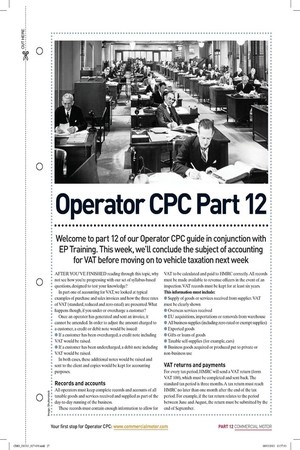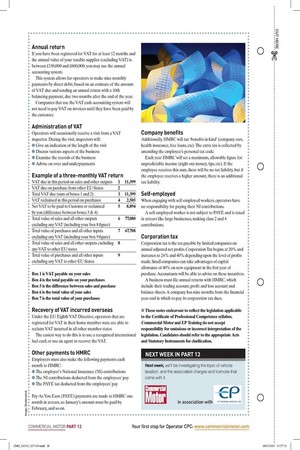Operator CPC Part 12 • • • • • •
Page 18

Page 19

If you've noticed an error in this article please click here to report it so we can fix it.
• • • • • • • • • • • • • • • • • • • • • • • • • • • • • • • • • • • • • • • • • • • • • • • • • • • • • • Welcome to part 12 of our Operator CPC guide in conjunction with EP Training. This week, well conclude the subject of accounting for VAT before moving on to vehicle taxation next week AFTER YOU'VE FINISHED reading through this topic, why not see how you're progressing with our set of syllabus-based questions, designed to test your knowledge?
In part one of accounting for VAT, we looked at typical examples of purchase and sales invoices and how the three rates of VAT (standard, reduced and zero-rated) are presented. What happens though, if you under or overcharge a customer?
Once an operator has generated and sent an invoice, it cannot be amended. In order to adjust the amount charged to a customer, a credit or debit note would be issued: • If a customer has been overcharged, a credit note including VAT would be raised.
• If a customer has been undercharged, a debit note including VAT would be raised.
In both cases, these additional notes would be raised and sent to the client and copies would be kept for accounting purposes.
Records and accounts All operators must keep complete records and accounts of all taxable goods and services received and supplied as part of the day-to-day running of the business.
These records must contain enough information to allow for VAT to be calculated and paid to HMRC correctly. All records must be made available to revenue officers in the event of an inspection. VAT records must be kept for at least six years. This information must include: • Supply of goods or services received from supplier. VAT must be clearly shown • Overseas services received • EU acquisitions, importations or removals from warehouse • All business supplies (including zero-rated or exempt supplies) • Exported goods • Gifts or loans of goods • Taxable self-supplies (for example, cars) • Business goods acquired or produced put to private or non-business use VAT returns and payments For every tax period, HMRC will send a VAT return (form VAT 100), which must be completed and sent back. The standard tax period is three months. A tax return must reach HMRC no later than one month after the end of the tax period. For example, if the tax return relates to the period between June and August, the return must be submitted by the end of September. Annual return If you have been registered for VAT for at least 12 months and the annual value of your taxable supplies (excluding VAT) is between £150,000 and £600,000, you may use the annual accounting system.
This system allows for operators to make nine monthly payments by direct debit, based on an estimate of the amount of VAT due and sending an annual return with a 10th balancing payment, due two months after the end of the year.
Companies that use the VAT cash-accounting system will not need to pay VAT on invoices until they have been paid by the customer.
Administration of VAT Operators will occasionally receive a visit from a VAT inspector. During the visit, inspectors will: • Give an indication of the length of the visit • Discuss various aspects of the business • Examine the records of the business • Advise on over and underpayments Example of a three-monthly VAT return VAT due in this period on sales and other outputs 1 11,399 VAT due on purchase from other EU States 2 Total VAT due (sum of boxes 1 and 2) 3 11,399 VAT reclaimed in this period on purchases 4 2,505 Net VAT to be paid to Customs or reclaimed by you (difference between boxes 3 & 4) 5 8,894 Total value of sales and all other outputs excluding any VAT (including your box 8 figure) 6 77,080 Total value of purchases and all other inputs excluding any VAT (including your box 9 figure) 7 67,708 Total value of sales and all other outputs excluding any VAT to other EU states 8 Total value of purchases and all other inputs excluding any VAT to other EU States 9 Box 1 is VAT payable on your sales Box 4 is the total payable on your purchases Box 5 is the difference between sales and purchase Box 6 is the total value of your sales Box 7 is the total value of your purchases Recovery of VAT incurred overseas Under the EU Eighth VAT Directive, operators that are registered for VAT in their home member state are able to reclaim VAT incurred in all other member states.
The easiest way to do this is to use a recognised international fuel card, or use an agent to recover the VAT.
Other payments to H M RC Employers must also make the following payments each month to HMRC: • The employer's National Insurance (NI) contributions • The NI contributions deducted from the employees' pay • The PAYE tax deducted from the employees' pay Pay As You Earn (PAYE) payments are made to HMRC one month in arrears, so January's amount must be paid by February, and so on. Company benefits Additionally, HMRC will tax 'benefits in kind' (company cars, health insurance, free loans, etc). The extra tax is collected by amending the employee's personal tax code.
Each year HMRC will set a maximum, allowable figure for unpredictable income (night out money, tips, etc). If the employee receives this sum, there will be no tax liability, but if the employee receives a higher amount, there is an additional tax liability.
Self-employed When engaging with self-employed workers, operators have no responsibility for paying their NI contributions.
A self-employed worker is not subject to PAYE and is taxed in arrears like large businesses, making class 2 and 4 contributions.
Corporation tax Corporation tax is the tax payable by limited companies on annual adjusted net profits. Corporation Tax begins at 20% and increases to 24% and 40% depending upon the level of profits made Small companies can take advantages of capital allowance of 40% on new equipment in the first year of purchase. Accountants will be able to advise on these incentives.
A business must file annual returns with HMRC, which include their trading account, profit and loss account and balance sheets. A company has nine months from the financial year-end in which to pay its corporation tax dues.
• These notes endeavour to reflect the legislation applicable to the Certificate of Professional Competence syllabus. Commercial Motor and EP Training do not accept responsibility for omissions or incorrect interpretation of the legislation. Candidates should refer to the appropriate Acts and Statutory Instruments for clarification.






































